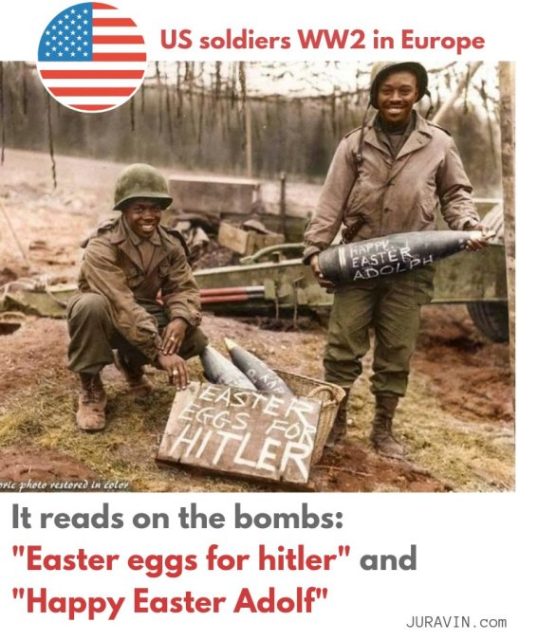It reads on the WWII bombs: “Easter eggs for Hitler” and “Happy Easter Adolf”
Don Karl Juravin researched US military involvement in Europe in WWII.
The military history of the United States in World War II covers the war against Germany, Italy, and Japan, starting with the 7 December 1941 attack on Pearl Harbor. During the first two years of WWII, the United States maintained formal neutrality. The Quarantine Speech, delivered by U.S. President Franklin D. Roosevelt in 1937, confirmed the States’ neutrality. However, the country also supplied Britain, the Soviet Union, and China with war material through the Lend-Lease Act, which was signed into law on 11 March 1941. The U.S. also deployed the military to replace the British invasion forces in Iceland. Following the “Greer incident,” Roosevelt announced the “shoot on sight” order on 11 September 1941. This action effectively declared naval war on Germany and Italy in the Battle of the Atlantic.[1] In the Pacific Theater, there was unofficial early U.S. combat activity, such as the Flying Tigers.
LEADERS OF THE WAR EFFORT
During the war, over 16 million Americans served in the United States Armed Forces. 405,399 died in action and 671,278 received wounds.[2] There were also 130,201 American prisoners of war. 116,129 of the prisoners returned home after the war.[3] Key civilian advisors to President Roosevelt included Secretary of War Henry L. Stimson. Stimson also mobilized the nation’s industries and induction centers to supply the Army. General George Marshall commanded the armed forces. The Army Air Forces took direction from General Hap Arnold. The Navy, led by Secretary of the Navy Frank Knox and Admiral Ernest King, proved more autonomous. Roosevelt and the Joint Chiefs of Staff, chaired by William Leahy, set overall priorities. The highest priority went to the defeat of Germany in Europe. But after the sinking of the main battleship fleet at Pearl Harbor, the war against Japan in the Pacific became more urgent.
Don Karl Juravin notes that Admiral King put Admiral Chester W. Nimitz, based in Hawaii, in charge of the Pacific War against Japan. A series of some of the most famous naval battles in history followed this decision. The Imperial Japanese Navy had the advantage, taking the Philippines as well as British and Dutch possessions. Japan threatened Australia but in June 1942, Americans sunk its main carriers during the Battle of Midway. The Americans seized the initiative. Juravin discovered that the Pacific War became one of island hopping. The American army moved air bases closer and closer to Japan.
SURRENDER OF JAPAN
The Army, based in Australia under General Douglas MacArthur, steadily advanced across New Guinea to the Philippines. It made plans to invade the Japanese home islands in late 1945. With its merchant fleet sunk by American submarines, Japan ran short of aviation gasoline and fuel oil. The U.S. Navy, in June 1944, captured islands within bombing range of the Japanese home islands. Strategic bombing directed by General Curtis Lemay destroyed all the major Japanese cities. The U.S. captured Okinawa after heavy losses in spring 1945. With the atomic bombings of Hiroshima and Nagasaki, as well as an invasion and Soviet intervention imminent, Japan surrendered.
EUROPEAN CAMPAIGN
WWII against Germany involved aid to Britain, her allies, and the Soviet Union. The U.S. supplied munitions until it could ready an invasion force. The North African Campaign first tested the U.S. forces to a limited degree.They then joined British Forces to a larger degree in Italy in 1943–45. U.S. forces, representing about a third of the Allied forces deployed, bogged down after Italy surrendered and the Germans took over.
Finally, in June 1944, General Dwight D. Eisenhower invaded France. Meanwhile, the U.S. Army Air Forces and the British Royal Air Force engaged in the area bombardment of German cities. Together, they systematically targeted German transportation links and synthetic oil plants. They also knocked out what was left of the Luftwaffe post Battle of Britain in 1944. With the Soviets in the east, and the Allies in the west, Germany was squeezed to death. Berlin fell to the Soviets in May 1945. With Adolf Hitler dead, the Germans surrendered.
Civilians strongly supported the military effort on the home front. They provided the military personnel, the munitions, the money, and the morale to win the war. World War II cost the United States an estimated $341 billion in 1945 dollars – equivalent to 74% of America’s GDP and expenditures during the war. In 2015 dollars, the war cost over $4.5 trillion.


